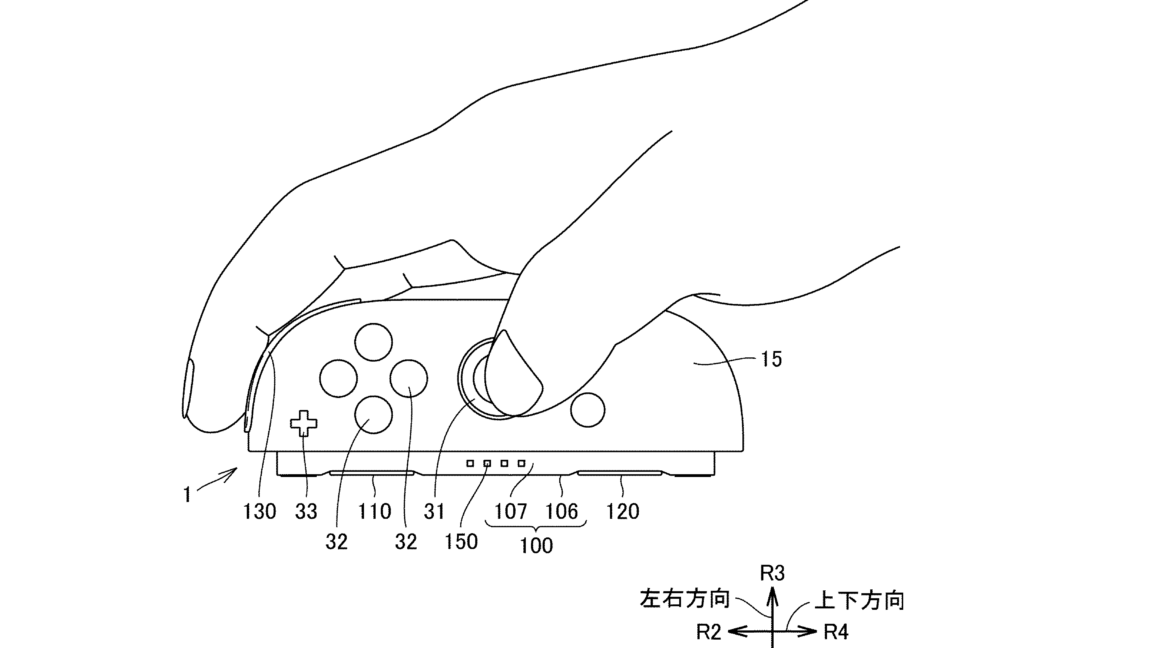
Nintendo patent explains Switch 2 Joy-Cons mouse operation mode
arstechnica.com
click click Nintendo patent explains Switch 2 Joy-Cons mouse operation mode Users can access thumbsticks, shoulder buttons while sliding Joy-Cons on a flat surface. Kyle Orland Feb 6, 2025 6:04 pm | 13 The old way of holding a Joy-Con (top) and the new way (bottom) Credit: Nintendo / WIPO The old way of holding a Joy-Con (top) and the new way (bottom) Credit: Nintendo / WIPO Story textSizeSmallStandardLargeWidth *StandardWideLinksStandardOrange* Subscribers only Learn moreIt's been a month since we first heard rumors that the Switch 2's new Joy-Cons could be slid across a flat surface to function like a computer mouse. Now, a newly published patent filed by Nintendo seems to confirm that feature and describes how it will work.The international patent was filed with the World Intellectual Property Organization in January 2023, but it was only published on WIPO's website on Thursday. The Japanese-language patentwhose illustrations match what we've seen of Switch 2 Joy-Con preciselyfeatures an English abstract describing "a sensor for mouse operation" that can "detect reflected light from a detected surface, the light changing by moving over the detected surface..." much like any number of optical computer mice. Schematic drawings in the patent show how the light source and light sensor are squeezed inside the Joy-Con, with a built-in lens for directing the light to and from each. A schematic diagram of the Switch 2's Joy-Con light sensor Credit: Nintendo / WIPO A schematic diagram of the Switch 2's Joy-Con light sensor Credit: Nintendo / WIPO A machine translation of the full text of the patent describes the controller as "a novel input device that can be used as a mouse and other than a mouse." In mouse mode, as described in the patent, the user cradles the outer edge of the controller with their palm and places the inner edge "on, for example, a desk or the like."In this configuration, the user's thumb can still access the analog stick (which is now pointing horizontally) while the index and middle fingers are positioned so the two shoulder buttons "can be operated as, for example, a right-click button and a left-click button," according to the patent. The patent describes this configuration as "easy to hold" or "easy to grip." It also goes to great lengths to explain how the shoulder buttons wrap around the curved top corner of the controller and thus are "easy to press" by pushing either downward or closer to horizontally with a finger.According to the patent, two Joy-Cons can be used simultaneously as mice, with one in each hand, or one can be used as a mouse while the other is held vertically as a more traditional Switch Joy-Con. Intriguingly, the patent suggests that the mouse mode might work when the controller is hovering up to 1 cm above the flat surface being used, which would put it at the higher end of usable lift-off distances used in PC gaming mice. A top view of the Joy-Con's "mosue operation" mode. Note how the thumb still has access to the analog stick while two fingers rest on the two should buttons. Nintendo / WIPOA top view of the Joy-Con's "mosue operation" mode. Note how the thumb still has access to the analog stick while two fingers rest on the two should buttons.Nintendo / WIPO Dual mouse mode! Nintendo / WIPODual mouse mode!Nintendo / WIPO You can use one Joy-Con in the traditional manner while using the other as a mouse. Nintendo / WIPOYou can use one Joy-Con in the traditional manner while using the other as a mouse.Nintendo / WIPODual mouse mode!Nintendo / WIPOYou can use one Joy-Con in the traditional manner while using the other as a mouse.Nintendo / WIPOWhile the other details of the Joy-Cons and gaming device described in the patent match up closely with what we know of the Switch 2, it's important to remember that the final hardware could differ from these early patented descriptions. For instance, the patent makes no mention of the stabilizing mounts that were shown clicking onto the edge of the Joy-Con before a mouse-like sliding section of the hardware's first-glimpse trailer last month.That said, the patent serves as strong evidence of just how the Switch Joy-Cons could emulate computer mice. We expect more details will be shared when Nintendo releases a Switch-focused Direct video on April 2.Kyle OrlandSenior Gaming EditorKyle OrlandSenior Gaming Editor Kyle Orland has been the Senior Gaming Editor at Ars Technica since 2012, writing primarily about the business, tech, and culture behind video games. He has journalism and computer science degrees from University of Maryland. He once wrote a whole book about Minesweeper. 13 Comments
0 Comments
·0 Shares
·147 Views


